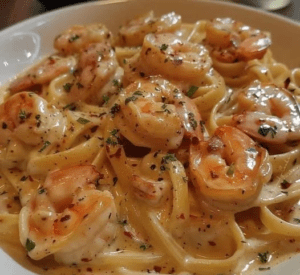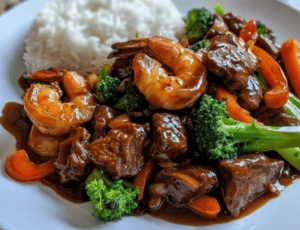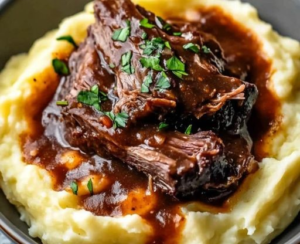
There’s something magical about a bowl of Vietnamese pho. It’s not just soup—it’s an experience. The deep, savory broth. The silky rice noodles. The contrast of thinly sliced beef with fresh herbs, crunchy bean sprouts, and a bright squeeze of lime. When it’s done right, pho has this ability to comfort, refresh, and satisfy all at once. And while grabbing a bowl from my favorite Vietnamese spot is always a treat, making it from scratch at home? That’s a whole new kind of joy.
I won’t lie—this isn’t a quick weeknight dinner. But it’s the kind of slow-cooked, from-the-heart recipe that makes your whole kitchen smell incredible and your soul feel nourished. Whether you’re tackling pho for the first time or you’re already in love with the process, I’m walking you through how I do it—from boiling the bones to topping each bowl just right.
Why I Love Making Pho at Home
The first time I made pho from scratch, I felt a little intimidated by the ingredient list. But once I got started, I realized that pho isn’t hard—it just asks for patience and care. And the reward is absolutely worth it.
- The broth is the heart of it all: Simmered for hours, infused with toasted spices, charred onions, and ginger. It’s what sets pho apart from every other soup.
- It’s fully customizable: From the cut of beef to the toppings, I can make it just the way I love.
- It’s freezer-friendly: I always make a big batch and freeze extra broth for future pho cravings.
- It’s better than takeout: There, I said it. Homemade pho has depth and clarity you just can’t rush.
Let’s get into it.
Ingredients You’ll Need
For the Broth:
- 5 to 6 pounds beef knuckles or leg bones
- 6 quarts cold water
- 2 large onions, quartered
- 4-inch piece fresh ginger, halved lengthwise
- 2 cinnamon sticks
- 1 tablespoon coriander seeds
- 1 tablespoon fennel seeds
- 6 whole star anise
- 6 whole cloves
- 1 black cardamom pod
- 1 ½ tablespoons fine sea salt
- ¼ cup fish sauce
- 1-inch piece yellow rock sugar (or substitute with 1 tablespoon granulated sugar)
For Assembly:
- 1 pound dried or fresh banh pho (flat rice noodles)
- 8 ounces eye of round, sirloin, or tri-tip steak, sliced paper-thin across the grain
- ¼ cup thinly sliced onions
- ¼ cup chopped cilantro leaves
Optional Table Toppings:
Fresh Thai basil, mint, bean sprouts, lime wedges, sliced chili peppers, hoisin sauce, sriracha, fish sauce
How I Make Authentic Pho (Step-by-Step)
1. Blanch and Clean the Bones
This step is essential for a clear broth. I place the bones in my largest stockpot and cover them with cold water. I bring it to a rapid boil for 3 to 5 minutes. Scum and foam rise to the top—this is exactly what we want to get rid of.
Then I drain the bones, rinse them under warm water, and give my stockpot a quick scrub. Back in go the bones, plus 6 quarts of fresh cold water.
2. Char the Onion and Ginger
While the bones are heating up again, I preheat my broiler and set the oven rack close to the top. I line a baking sheet with foil and place the onion quarters and ginger halves cut-side down. After 10 to 15 minutes under the broiler (flipping once), they’re blackened and fragrant—just what the broth needs.
3. Toast the Spices
In a dry pan over low heat, I toast the cinnamon, coriander, fennel, star anise, cloves, and cardamom for about 5 minutes, stirring often. Once they’re fragrant and slightly darkened, I bundle them in cheesecloth and tie it closed with twine. This little spice satchel goes into the broth to slowly release flavor without leaving stray bits behind.
4. Build the Broth
I bring the water and bones to a boil, then lower it to a gentle simmer. In go the charred onion and ginger, spice pouch, salt, fish sauce, and rock sugar. Then I let it do its thing for 3 hours, uncovered. Every so often, I skim off the foam and fat that float to the surface for a clean, golden broth.
Pro tip: If I’m planning ahead, I refrigerate the strained broth overnight. The fat solidifies at the top, making it easy to scoop off before reheating.
5. Strain and Finish the Broth
Once it’s simmered and deepened in flavor, I remove the bones, onion, ginger, and spice bag. Then I strain the broth through a fine mesh sieve or cheesecloth-lined colander. What’s left is clear, rich, and full of body.
I bring it back to a gentle simmer while I prep the noodles and toppings.
Assembling the Bowls
1. Prepare the Noodles
If I’m using dried noodles, I soak them in hot water for 15–20 minutes until pliable and opaque. Then I briefly boil them—just 10 seconds or so—and drain them well. If I’m lucky enough to have fresh noodles, I rinse them with cold water and skip the boiling step.
I divide the noodles between bowls, filling each about one-third of the way.
2. Add the Raw Beef
I lay thin slices of raw beef right over the noodles. The trick is slicing it as thinly as possible—freezing the meat for 15 minutes first helps a lot. The hot broth will cook it just enough.
3. Ladle the Broth and Garnish
I pour the simmering broth over the beef, watching as it gently cooks and the aromas rise up. Then I top it with sliced onion and fresh cilantro.
Everything else—bean sprouts, basil, mint, lime, hot sauce—I serve on the side, so everyone can build their perfect bowl.
My Favorite Pho Add-Ons
These are the things I always put on the table for a true pho experience:
- Fresh Thai basil and mint for herbaceous contrast
- Bean sprouts for crunch
- Lime wedges for brightness
- Thin-sliced chili for a little fire
- Hoisin and sriracha for dipping and drizzling
Everyone customizes their own bowl, which is part of the fun.
FAQs From My Kitchen to Yours
Q: Can I make the broth ahead of time?
A: Absolutely—and I recommend it. The flavor deepens overnight, and it makes dinner prep a breeze.
Q: What’s the best beef cut for topping?
A: I like eye of round for its tenderness and thinness. Sirloin or tri-tip work great too—just slice across the grain and go thin.
Q: Can I freeze the broth?
A: Yes! I freeze it in quart containers or ice cube trays for easy reheating.
Q: Is it okay to skip the black cardamom or rock sugar?
A: You can, but if you can find them, use them. They give pho its unique depth and slightly smoky-sweet note.
Final Thoughts
Making pho at home is a labor of love—but once you do it, you’ll never see a bowl of soup the same way again. The slow-simmered broth, the delicate beef, the customizable toppings… it’s a sensory experience in a bowl. I’ve made this on rainy Sundays, for special family dinners, and even just because I missed the comforting flavors of my favorite pho shop.
If you’ve been curious about making pho from scratch, let this be your sign. It’s not just cooking—it’s crafting something deeply satisfying and truly soulful.
And trust me, once that aroma starts filling your kitchen, you’ll be hooked.

The Most Soul-Soothing Vietnamese Pho I’ve Ever Made at Home
Ingredients
- 1 tablespoon coriander seeds
- 1 tablespoon fennel seeds
- 1 tablespoon granulated sugar
- 1 pound dried or fresh banh pho (flat rice noodles)
- 1 onion, halved
- 1 ginger root, halved
- 2 pounds beef bones (or oxtail)
- 1 pound thinly sliced beef (such as sirloin or brisket)
- Fresh herbs (basil, cilantro, mint)
- Bean sprouts
- Lime wedges
- Soy sauce (optional for seasoning)
- Salt to taste
Instructions
- Toast the coriander and fennel seeds in a dry pan over medium heat until fragrant.
- In a large pot, combine the beef bones, onion, ginger, and water. Bring to a boil, then reduce heat and simmer for at least 30 minutes to develop flavor.
- Add the toasted spices and sugar to the pot, simmering for an additional 1-2 hours. Skim off any impurities that rise to the surface.
- Prepare the banh pho according to package instructions and set aside.
- Strain the broth through a fine mesh sieve to remove solids.
- Return the broth to the pot and season with salt and soy sauce to taste.
- To serve, place a portion of cooked noodles in a bowl, top with raw sliced beef, and ladle hot broth over the top. Garnish with fresh herbs, bean sprouts, and lime wedges.




Leave a Reply